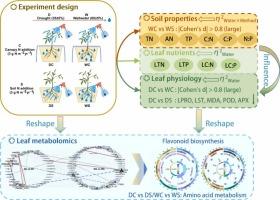Canopy nitrogen addition reshapes leaf physiological-metabolic processes in Populus euphratica seedlings with a water dependency
IF 6.2
1区 农林科学
Q1 AGRICULTURAL ENGINEERING
引用次数: 0
Abstract
Compared to soil nitrogen (N) addition, canopy N addition offers a more ecologically relevant simulation of natural N deposition, and plays a pivotal role in regulating plant physiological metabolism and adaptive strategies. However, it is uncertain whether this critical process is water-dependent. This study systematically revealed the synergistic response mechanism of Populus euphratica seedlings to water treatment (drought stress vs. well-watered) and N addition method (canopy N addition vs. soil N addition). The results showed that: (1) The interactive effects significantly regulated soil nutrient characteristics, with N addition method exerting a pronounced positive effects on ammonium nitrogen (AN) and soil organic carbon (SOC) (P < 0.05); (2) At the leaf physiological level, canopy N addition under drought stress significantly decreased the contents of Proline (LPRO) and Starch (LST), along with declining trends in Malondialdehyde (MDA) levels, Peroxidase (POD) and Ascorbate peroxidase (APX) activities, indicating its capacity to alleviate drought stress; (3) Metabolomic analysis revealed that drought stress induced changes in various secondary metabolites, including Carbohydrates and carbohydrate conjugates (7.55 %), Amino acids, peptides, and analogues (5.03 %), Flavonoid glycosides (4.40 %), enriched in pathways such as Arachidonic acid metabolism and Flavonoid biosynthesis. Canopy N addition markedly expanded drought-responsive metabolites, predominantly influencing primary metabolism (amino acid metabolism); (4) Structural equation modeling identified that water treatment exerted stronger direct effects on differential metabolites (DMs) variations than N addition method, while the latter indirectly drove metabolic reprogramming through modulation of leaf nutrients and soil N availability. These findings unveil desert plants’ balanced strategies of physiological defense and resource acquisition through water-nitrogen coupling, establishing nutrient stewardship frameworks for maintaining arid ecosystem equilibrium under global climatic perturbations scenarios.

林冠氮添加对水分依赖的胡杨幼苗叶片生理代谢过程的影响
与土壤氮素添加相比,冠层氮素添加更能模拟自然氮沉降,在调节植物生理代谢和适应策略方面发挥关键作用。然而,尚不确定这一关键过程是否依赖于水。本研究系统揭示了胡杨幼苗对水分处理(干旱胁迫vs丰水处理)和施氮方式(冠层施氮vs土壤施氮)的协同响应机制。结果表明:(1)交互作用显著调节土壤养分特征,其中施氮方式对铵态氮(AN)和土壤有机碳(SOC)有显著的正向影响(P <; 0.05);(2)在叶片生理水平上,干旱胁迫下冠层补氮显著降低了叶片脯氨酸(LPRO)和淀粉(LST)含量,降低了丙二醛(MDA)含量、过氧化物酶(POD)和抗坏血酸过氧化物酶(APX)活性,表明其具有缓解干旱胁迫的能力;(3)代谢组学分析表明,干旱胁迫诱导了多种次生代谢物的变化,包括碳水化合物和碳水化合物缀合物(7.55 %)、氨基酸、多肽和类似物(5.03 %)、类黄酮苷(4.40 %),丰富了花生四烯酸代谢和类黄酮生物合成等途径。冠层氮添加显著增加了干旱响应代谢产物,主要影响初级代谢(氨基酸代谢);(4)结构方程模型表明,水处理对差异代谢物(DMs)变化的直接影响强于添加氮,而添加氮通过调节叶片养分和土壤氮有效性间接驱动代谢重编程。这些发现揭示了荒漠植物通过水氮耦合进行生理防御和资源获取的平衡策略,建立了在全球气候扰动情景下维持干旱生态系统平衡的养分管理框架。
本文章由计算机程序翻译,如有差异,请以英文原文为准。
求助全文
约1分钟内获得全文
求助全文
来源期刊

Industrial Crops and Products
农林科学-农业工程
CiteScore
9.50
自引率
8.50%
发文量
1518
审稿时长
43 days
期刊介绍:
Industrial Crops and Products is an International Journal publishing academic and industrial research on industrial (defined as non-food/non-feed) crops and products. Papers concern both crop-oriented and bio-based materials from crops-oriented research, and should be of interest to an international audience, hypothesis driven, and where comparisons are made statistics performed.
 求助内容:
求助内容: 应助结果提醒方式:
应助结果提醒方式:


